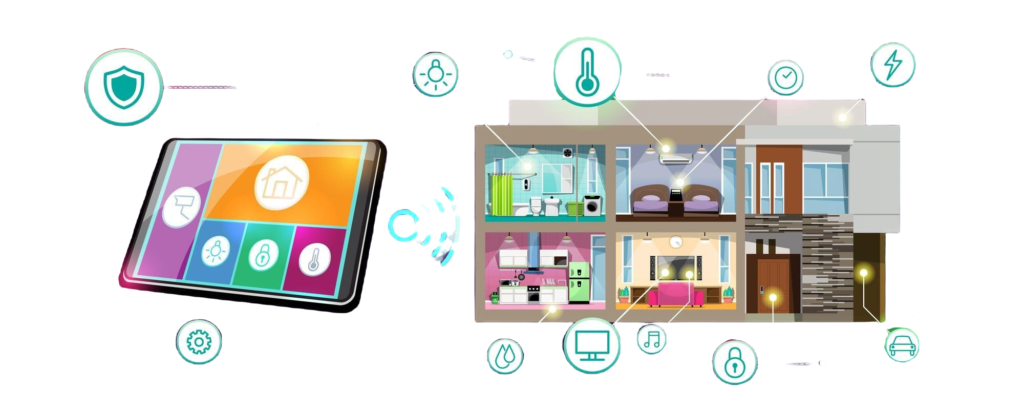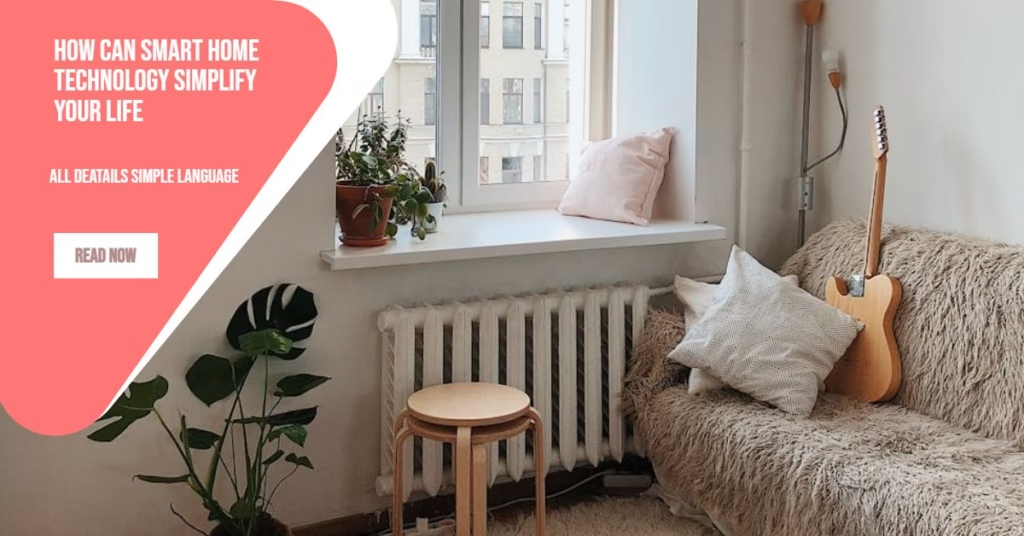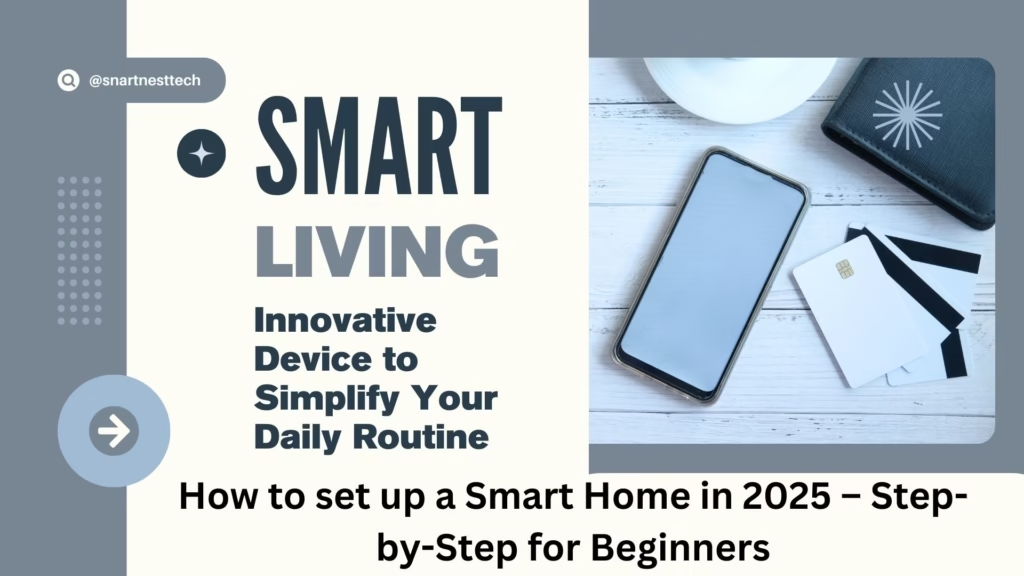How can smart home technology simplify your life?
Table of Contents

Imagine coming home tired after a long day of work. With just one simple voice command, the lights automatically turn on, the AC sets to your perfect comfort level, and your favorite series or movie starts playing on the TV. That’s the magic of smart home technology!
In today’s modern world, smart home technology is no longer just a luxury; it has become an essential part of people’s lives. With the help of the internet and innovative devices, our homes are becoming smarter, and we should take full advantage of this technology. Smart home technology makes daily life more comfortable, while also enhancing security and efficiency.
Smart home devices like speakers, security cameras, thermostats, and smart plugs help you complete your daily tasks easily and conveniently.
The use of smart home technology is growing rapidly. According to 2024 research, many families have already started using it. Companies are also working on making their products more user-friendly and accessible so that more people can benefit from this technology.
With smart home technology, you can save valuable time and energy. Even if you are away from home, you can keep it secure with these devices. From energy-efficient lights to smart cameras, these gadgets make life much easier to live.
The era of smart homes has already begun, and if you want to make your home smarter, this technology is ready to help you get started!
What is Smart Home Technology?
Smart home technology is a system that connects all the devices in your home and allows them to work together. These devices are controlled through the Internet of Things (IoT). With this technology, your daily tasks become much easier. For example, you can turn on the lights, set the AC to your comfort, operate cameras, and control other devices using just one app or even your voice.
Types of Smart Home Technologies:
There are two main types of smart home systems:
- Wired Systems:
-
- These systems require professional installation because they involve wiring and fixed setups.
- Example: High-end security systems and advanced home automation setups.
- Wireless Systems:
-
- These systems use wireless technologies like Wi-Fi, Bluetooth, or Zigbee.
They are easy to install, and you can control them using your smartphone or voice assistants.
Popular Platforms for Smart Homes:

- Amazon Alexa:
You can use voice commands to turn off lights, set timers, and manage your shopping lists. - Google Home:
Google’s system helps you easily control your devices and integrates seamlessly with other Google services. - Apple HomeKit:
A highly secure and user-friendly option for Apple users, where you can control your home devices using your iPhone or Siri.
Smart home technology allows all your devices to work as one synchronized system, making your life more comfortable, efficient, and secure!
Everyday Conveniences Offered by Smart Homes
Smart home technology helps you complete your daily tasks easily and conveniently. It allows you to control things hands-free or remotely and makes your home more efficient by managing automated routines.
- Voice-Controlled Assistance:
With voice assistants like Amazon Alexa, Google Assistant, and Apple Siri, you can manage your daily tasks with simple voice commands.
- You can set timers, get weather updates, or stream music—all hands-free!
- Example: Say, “Alexa, turn on the lights” or “Hey Google, what’s the weather today?”
- Remote Control and Access:
Smart home systems let you control your home and keep it secure, even when you are not there.
- Examples: You can lock doors, manage appliances, or check security cameras remotely.
- Geofencing: This feature tracks your location and automates tasks. For instance, lights turn on or the AC starts when you approach your home.
- Automated Routines:
Smart homes allow you to automate multiple devices at the same time.
- Example: A “Good Night” mode can lock all doors, dim the lights, and turn off unnecessary electronics with one command.
- These routines eliminate the need to manage everything manually.
- Smart Kitchen Devices:
Smart technology also makes your kitchen tasks easier.
- Smart Refrigerators: They notify you about expired food items.
- Smart Ovens: They allow remote preheating and provide recipe guidance.
Smart home technology makes your daily tasks simple and stress-free, saving you time and helping you live a more organized life.
Energy Efficiency and Cost Savings

Smart home technology helps you save energy and reduce your bills. These devices are energy-efficient and can optimize your energy usage.
- Smart Thermostats:
Smart thermostats make it easy to manage your home’s temperature while optimizing energy usage to lower bills.
- Learning User Preferences: These devices learn your daily routine and adjust the temperature automatically. For example, they reduce cooling when you’re not home and set the perfect temperature before you arrive.
- Seasonal Energy Reports: Smart thermostats provide detailed energy usage reports, helping you plan better for different seasons.
- Smart Lighting Systems:
Smart lighting systems are designed to conserve energy with adjustable and eco-friendly options.
- Adjustable Brightness and Color: You can change the brightness and color of lights based on your needs or mood, which helps reduce energy waste.
- Solar-Powered or Energy-Efficient Bulbs: These bulbs consume less electricity and provide long-term savings.
- Smart Plugs and Energy Monitors:
Smart plugs and energy monitors help you track your appliance usage and find opportunities to save energy.
- Tracking Appliance Usage: These devices not only track usage but also identify appliances that consume extra energy.
- Examples: Popular options like TP-Link Kasa and Wemo Smart Plugs help you monitor and control energy consumption effectively.
Smart home technology not only helps the environment but also significantly reduces your expenses!
Enhanced Home Security and Peace of Mind

Smart home technology makes it very easy to keep your home secure and gives you peace of mind. These devices provide real-time updates and instant alerts, ensuring your home stays safe.
- Smart Doorbells and Cameras:
Smart doorbells and cameras let you monitor activities outside your home in real-time.
- Real-Time Notifications: When someone rings the doorbell, you get a notification and can check the live video feed.
- Facial Recognition: Some advanced cameras can recognize familiar faces and alert you if an unknown person is detected.
- Cloud Storage: You can save the recorded footage in the cloud, which is helpful for future reference.
- Motion Detectors and Smart Alarms:
Motion detectors and smart alarms provide instant alerts for unauthorized activities.
- Instant Alerts: If someone tries to enter without permission or there is unusual activity, you get notified immediately.
- These alerts can be sent directly to your smartphone.
- Smart Locks:
Smart locks make locking and unlocking your doors simple while improving both security and convenience.
- Keyless Entry: There’s no need to carry keys; you can use a passcode or app to enter your home.
- Temporary Access for Guests: You can control temporary access for visitors.
- Integration with Voice Assistants: Operate smart locks using voice commands through Alexa, Google Assistant, or Siri.
- Integration with Monitoring Services:
Your smart home can be integrated with professional monitoring services that provide round-the-clock security.
- Examples: Ring and ADT Smart Home services offer real-time monitoring and emergency assistance.
With smart home security, you can protect your home even when you’re away, helping you stay relaxed and stress-free.
Improving Home Comfort and Personalization
Smart home technology helps make your home more comfortable and customized to your personal style. These features let you match your home to your mood and lifestyle perfectly.
- Smart Climate Control:
Smart climate control systems help create a comfortable environment at home.
- Humidity Sensors: These sensors help maintain the right level of humidity in your home.
- Room-Specific Temperature Control: You can set different temperatures for each room, which also helps save energy.
- Air Quality Monitoring: You can monitor the air quality in your home and take timely actions, which is beneficial for your health.
- Customizable Lighting Ambiance:
Lighting systems can be customized based on your mood, occasion, or activity.
- Color-Changing Lights: You can change the light colors to set the mood, whether it’s for movie nights, celebrations, or relaxing evenings, creating the perfect ambiance.
- Smart Entertainment Systems:
Smart entertainment systems help you set up the perfect entertainment experience at home.
- Multi-Room Audio: Play the same song in multiple rooms at the same time.
- Voice-Controlled Streaming: Use voice commands to stream your favorite show, movie, or song easily.
- Personalized Recommendations: Entertainment apps learn your preferences and provide suggestions based on what you like.
With smart home features, your home becomes perfectly suited to your comfort and preferences, giving you a cozy and personalized experience!
Accessibility for Elderly and Disabled Users
Smart home technology greatly benefits elderly and disabled users by offering assistive features that make daily tasks easier and safer. These technologies improve their quality of life by providing extra support and making their homes more accessible.
- Assistive Technologies:
Voice-activated controls help users with mobility challenges to perform everyday tasks hands-free.
- Voice-Activated Controls: These controls let users manage lights, thermostats, and appliances by simply speaking commands, making it easier for those with limited mobility to control their home environment.
- Smart Health Monitoring Devices:
Health-monitoring devices keep track of vital signs and help ensure safety and well-being.
- Fall Detection Sensors: These sensors detect if a person has fallen and send alerts to caregivers or family members immediately.
- Medication Reminders: Smart devices can send reminders for taking medications on time, improving health management.
- Emergency Alerts: These devices can send out emergency alerts in case of accidents or urgent health issues, ensuring quick response from emergency services.
- Smart Home Alerts:
Smart home devices can also provide notifications for potential hazards, improving safety.
- Fire, Water Leaks, and Gas Leak Alerts: Sensors can detect hazards like fire, water leaks, or gas leaks and immediately notify the user or emergency contacts to prevent serious accidents.
With smart home technology, elderly and disabled users can enjoy greater independence, safety, and comfort in their everyday lives.
Sustainability Benefits of Smart Home Technology
Smart home technology not only makes life easier but also helps promote sustainability by reducing energy usage, conserving resources, and encouraging eco-friendly habits. Here’s how:
- Reduced Carbon Footprint:
Smart home systems help reduce your carbon footprint by optimizing energy consumption.
- Efficient Energy Use: Smart thermostats, lighting, and appliances automatically adjust to ensure energy is used efficiently, reducing unnecessary consumption and lowering overall carbon emissions.
- Water Conservation:
Smart home technology helps conserve water, an essential resource, with automatic systems that adjust usage based on environmental conditions.
- Smart Sprinklers: These sprinklers monitor weather conditions, adjusting watering schedules to ensure plants are watered efficiently, preventing water waste during rain or cooler weather.
- Waste Management:
Smart home systems also encourage better waste management by tracking and improving recycling habits.
- Smart Garbage Cans: These bins can monitor what is being thrown away and help users keep track of recycling habits. Some even send reminders to separate recyclables, ensuring less waste ends up in landfills.
By integrating these smart systems, homes can significantly reduce their environmental impact, promoting sustainability and a greener future.
Challenges and Solutions
While smart home technology offers numerous benefits, there are a few challenges that users may encounter. However, these challenges can be addressed with smart solutions to ensure a seamless experience.
- Initial Costs and Setup:
The initial cost of smart home devices and setup can be a concern for many users.
- Solution: Start with budget-friendly entry-level devices like smart plugs, lights, or thermostats. These affordable options can be a good introduction to smart home technology without requiring a significant investment. As you become more familiar with the system, you can gradually upgrade to more advanced devices.
- Privacy and Security Concerns:
Privacy and security are important concerns with connected devices that store data or are linked to the internet.
- Solution: Ensure that your smart home devices are secured with strong encryption protocols and are connected to a secure Wi-Fi network. Regular device updates and using two-factor authentication where possible can also help safeguard your data. Be mindful of the permissions and privacy settings of each device, ensuring they align with your security preferences.
- Learning Curve:
The variety of devices and features can make it seem complicated for new users.
- Solution: Many smart home products come with user-friendly apps and tutorials to guide you through the setup and operation. Brands like Amazon, Google, and Apple provide step-by-step instructions and customer support to make the learning process easier. As you use the devices more, you’ll become more comfortable with their features and functions.
By addressing these challenges with thoughtful solutions, you can enjoy the full potential of smart home technology while overcoming any initial hurdles.
Conclusion
Smart home technology has revolutionized the way we live, making daily life more convenient, secure, and efficient. From automating routine tasks to saving energy and enhancing security, these innovations simplify our lives while offering long-term benefits.
If you’re new to smart homes, start small with affordable devices like smart plugs or light bulbs, and gradually expand as you discover the value of these technologies. The journey to a smarter, more connected home begins with just one device!
Stay tuned to SmartNestTech.com for more tips, insights, and recommendations on how to make the most of smart home technology. Let’s make your home smarter together!
FAQs: All About Smart Home Technology
- What is smart home technology?
Smart home technology uses devices connected via the internet to automate and control functions like lighting, security, temperature, and entertainment. You can manage these systems through apps, voice commands, or automated routines. - Do I need an expensive setup to start with smart home technology?
No, you can begin with budget-friendly devices like smart plugs, light bulbs, or speakers. As you grow comfortable, you can invest in more advanced devices for a fully integrated system. - Are smart home devices secure to use?
Yes, they are secure as long as you use strong passwords, enable two-factor authentication, and keep your devices updated. Additionally, always use a secure Wi-Fi network to protect your data. - Can smart home devices save energy?
Absolutely! Devices like smart thermostats, energy-efficient lighting, and smart plugs optimize energy usage, reducing your bills and your carbon footprint. - What are some examples of smart home devices?
Popular smart home devices include:
- Smart speakers like Amazon Echo or Google Nest
- Smart thermostats like Nest or Ecobee
- Smart locks and cameras for security
- Smart lighting systems like Philips Hue
- Do I need a high-speed internet connection for a smart home?
Yes, a stable internet connection is essential, especially for devices that require real-time communication, like smart cameras or voice assistants. - Can smart home devices work without Wi-Fi?
Some devices have offline modes, but most require Wi-Fi for full functionality, such as remote control or integration with other devices. - Are smart homes beneficial for elderly or disabled users?
Yes, smart homes provide accessibility through voice-activated controls, health monitoring devices, and safety alerts, enhancing their quality of life and independence. - How can I ensure my smart home is eco-friendly?
You can make your smart home sustainable by:
- Using energy-efficient devices
- Installing smart sprinklers to save water
- Monitoring and reducing energy usage with smart plugs
- Can I control my smart home while traveling?
Yes, you can control your smart home remotely via apps on your smartphone. You can check cameras, lock/unlock doors, or adjust temperatures even when you’re not at home. - What are the common challenges of smart home technology?
Some challenges include:
- High initial costs
- Privacy and security concerns
- A learning curve for new users
These can be addressed by starting small, securing devices properly, and using user-friendly platforms.
- Which is the best smart home ecosystem to start with?
It depends on your preference:
- Amazon Alexa: Great for wide compatibility
- Google Home: Seamless integration with Google services
- Apple HomeKit: Ideal for Apple users prioritizing privacy.
Related
Discover more from
Subscribe to get the latest posts sent to your email.



